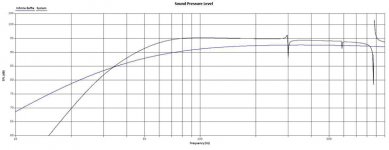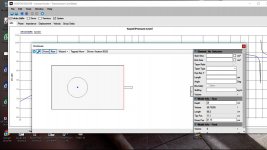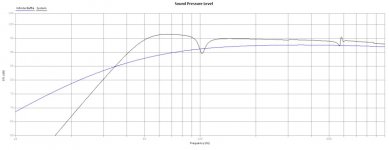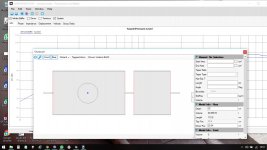Is it waste of time? These are sims of Visaton BG20 in BR box vs same driver in DCR box (make your own conclusion):
Attachments
It is a same driver (Visaton BG20) in same BR box (bigger volumes) of 59,5 liters tuned to 39,5 Hz and all vents are 7 cm diameters, length of 7,3 cm.
The second volume is exactly half of the bigger one (29,5 l) as Mr. Augspurger recommended.
The stuffing is same in both simulations.
The second volume is exactly half of the bigger one (29,5 l) as Mr. Augspurger recommended.
The stuffing is same in both simulations.
Last edited:
for a given same total volume, overall tuning, and driver TSP, the DCR (as described by G. Augspurger with 2:1 chamber ratio and 3 identical vents) will have basically the same low end of the single chamber reflex, plus a notch in the response about an octave above tuning. Any superiority might have to be a subjective call. When that cabinet's article was first introduced, it was assumed there was some magic involved.
(it is interesting to hear the vent output shift)

(it is interesting to hear the vent output shift)

Last edited:
freddi, thanks for proving my point - DCR is no better than regular bass reflex box. In fact, it is much worse and can't be described as a hi-fi box at all, because of that huge notch in the middle of the bass frequency range. With other combination of DCR volumes and tuning frequencies that notch can be tamed a little bit, but it will be there nonetheless.
some years later, G.L. Augspurger illustrated the classic DCR's behavior with a program he wrote. Normally its excursion damping is like the simulation below, but IIRC when introducing some damping material in the interconnecting vent (or more practical, a few layers of cheesecloth over one end of the interconnecting vent), notch depth will be lessened - as will effect on cone excursion.

G.A. Briggs may have used a type of of DCR before Augspurger's article appeared (?) Briggs' book "Loudspeakers" had a number of two chamber bass
reflex cabinet plans, each with a 2:1 chamber ratio, a single exit port, and a divider with saw-blade width slits which Briggs called
an "acoustic filter" (I thought perhaps he was tying to deal with limiting excursion from turntable rumble - ?)
here's one of those for a fullrange 8" driver - something like an AN8 with rising response might work

btw - my tall K18 has a "rear shelf" which divides its rear section into two volumes, a port like K15, and curved reflector
- the low mass 18" speaker rattles out to 4KHz. Karlson seem to be good for power handlng and excursion limiting -
if not for ultimate LF extension (although Exemplar used a retuned and boosted K15 for subwoofer)


G.A. Briggs may have used a type of of DCR before Augspurger's article appeared (?) Briggs' book "Loudspeakers" had a number of two chamber bass
reflex cabinet plans, each with a 2:1 chamber ratio, a single exit port, and a divider with saw-blade width slits which Briggs called
an "acoustic filter" (I thought perhaps he was tying to deal with limiting excursion from turntable rumble - ?)
here's one of those for a fullrange 8" driver - something like an AN8 with rising response might work

btw - my tall K18 has a "rear shelf" which divides its rear section into two volumes, a port like K15, and curved reflector
- the low mass 18" speaker rattles out to 4KHz. Karlson seem to be good for power handlng and excursion limiting -
if not for ultimate LF extension (although Exemplar used a retuned and boosted K15 for subwoofer)

Last edited:
No, I haven't missed the point. Look at the simulation of max excursion which freddi kindly provided - max excursion for both enclosures is below 80 Hz, where both enclosures behave almost identically (and the power handling is identical). Why we should be worried about excursion at some higher frequency point, when it is lower than the maximum?You've cmpletely missed the point. It's about excursion and power handling.
Conventional BR is superior (or equal) over DCR at every possible aspect - smooth frequency response, less complex enclosure, the same low-frequency reach, the same max excursion and the same power handling.
Last edited:
No, it can not be optimized - that horrible notch is always there, it is an inherent feature of the DCR enclosure.
How can we compare enclosure A and enclosure B with the same driver? The first obvious comparison is frequency response - if they are identical (or very similar), than enclosure with the smaller (total) volume wins. Or, if the volumes are identical, than the simpler construction enclosure wins.
If you optimize enclosure A for low frequency extension and than deliberately choose smaller volume for the enclosure B to make it to be with inferior low frequency extension only to "prove" that enclosure A is better, than you are right. Otherwise...
If we turn a blind eye to the DCR notch, frequency response of the optimized DCR enclosure is almost identical to the optimized BR. Both optimized enclosures have the same total volume, but the DCR has more complex enclosure to build. And that horrible notch...
How can we compare enclosure A and enclosure B with the same driver? The first obvious comparison is frequency response - if they are identical (or very similar), than enclosure with the smaller (total) volume wins. Or, if the volumes are identical, than the simpler construction enclosure wins.
If you optimize enclosure A for low frequency extension and than deliberately choose smaller volume for the enclosure B to make it to be with inferior low frequency extension only to "prove" that enclosure A is better, than you are right. Otherwise...
If we turn a blind eye to the DCR notch, frequency response of the optimized DCR enclosure is almost identical to the optimized BR. Both optimized enclosures have the same total volume, but the DCR has more complex enclosure to build. And that horrible notch...
Hi Sonce - what about any conceivable use of the DBR which has one internal port and one external port? G.A. Briggs reflex examples looked that way other than the partition having saw-blade width slits.
What was Briggs trying to accomplish with the resistive slit partition ? (could it have been to limit cone excursion from turntable rumble ? - something else ?)


What was Briggs trying to accomplish with the resistive slit partition ? (could it have been to limit cone excursion from turntable rumble ? - something else ?)


Last edited:
Hi freddi - food for thought! Making internal port resistive certainly will make the notch not so objectionable (both for DCR and DBR), but also will increase excursion at that frequency - making it closer to a conventional BR. But your question about subsonic (below 16 Hz) behavior is really interesting, I haven't thought about that. It may have some benefit in the subsonic region, but I suspect that will spoil low frequency extension.
Could you simulate DBR with the same driver and total volume as in previous DCR and BR examples, please? It will be interesting to compare DBR, DCR and BR head-to-head.
Could you simulate DBR with the same driver and total volume as in previous DCR and BR examples, please? It will be interesting to compare DBR, DCR and BR head-to-head.
Last edited:
being almost 69, I well remember vented boxes and turntable rumble effects watching cones move 3/4" peak to peak when their linear excursion was more like 1/4" peak to peak 
here's a Fane 15TC in single vs DBR, each 120 liters and tuned about the same (going by cone minimum excursion)

IF I did the Augspurger - Weems - Marsh DCR right - it looks extra terrible with the 15" Fane fullrange (triple cone)

here's a Fane 15TC in single vs DBR, each 120 liters and tuned about the same (going by cone minimum excursion)

IF I did the Augspurger - Weems - Marsh DCR right - it looks extra terrible with the 15" Fane fullrange (triple cone)

Last edited:
Going back to the DBR above, I must have tricked (???) hornresp somehow into giving a lower excursion output as when I went back to double-check
- max excursion below tuning was similar to the single reflex and the Augspurger DCR
here's that excursion plot the second time around

- max excursion below tuning was similar to the single reflex and the Augspurger DCR
here's that excursion plot the second time around

- Status
- This old topic is closed. If you want to reopen this topic, contact a moderator using the "Report Post" button.
- Home
- Loudspeakers
- Full Range
- DCR (dual chamber reflex) which port method is correct



